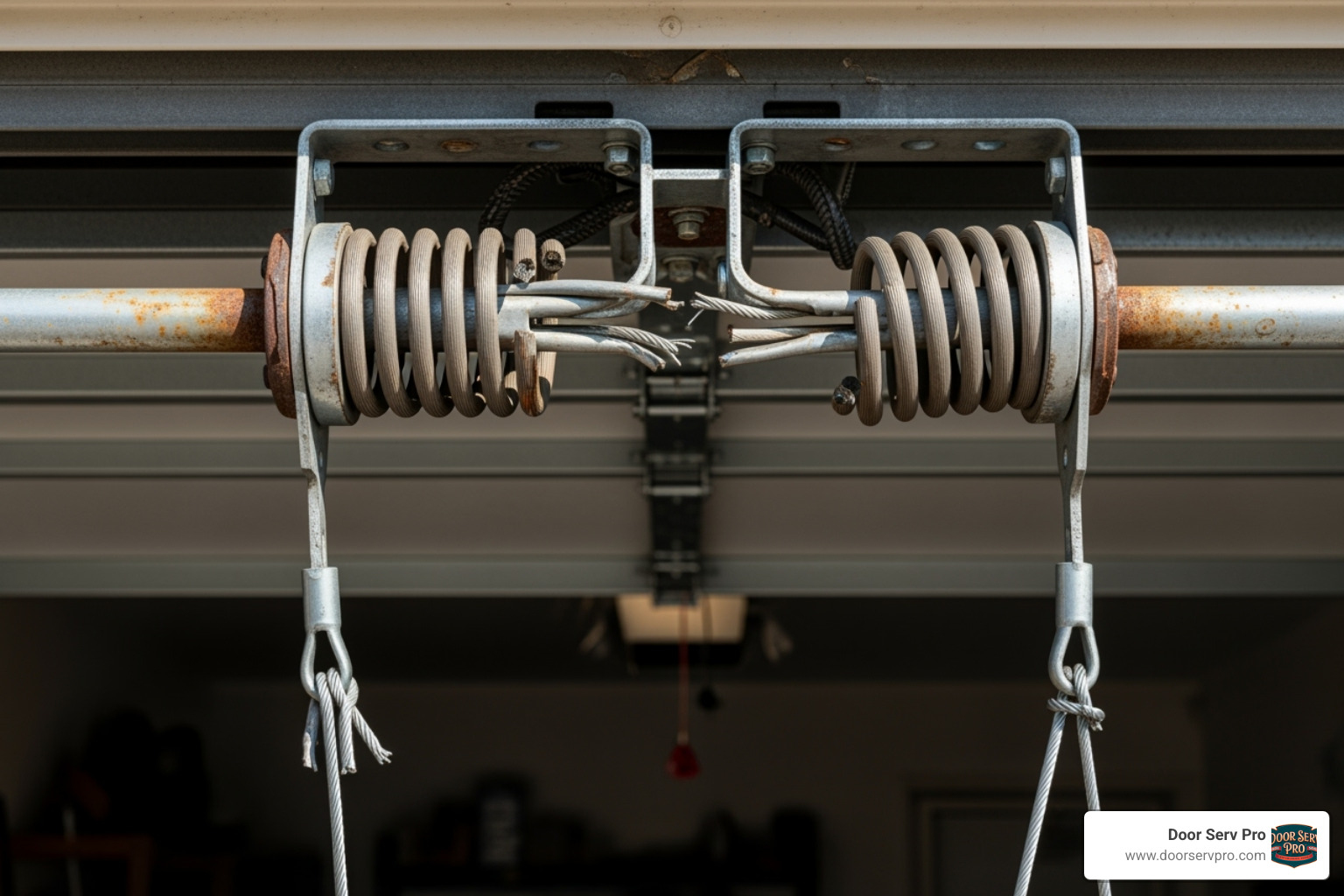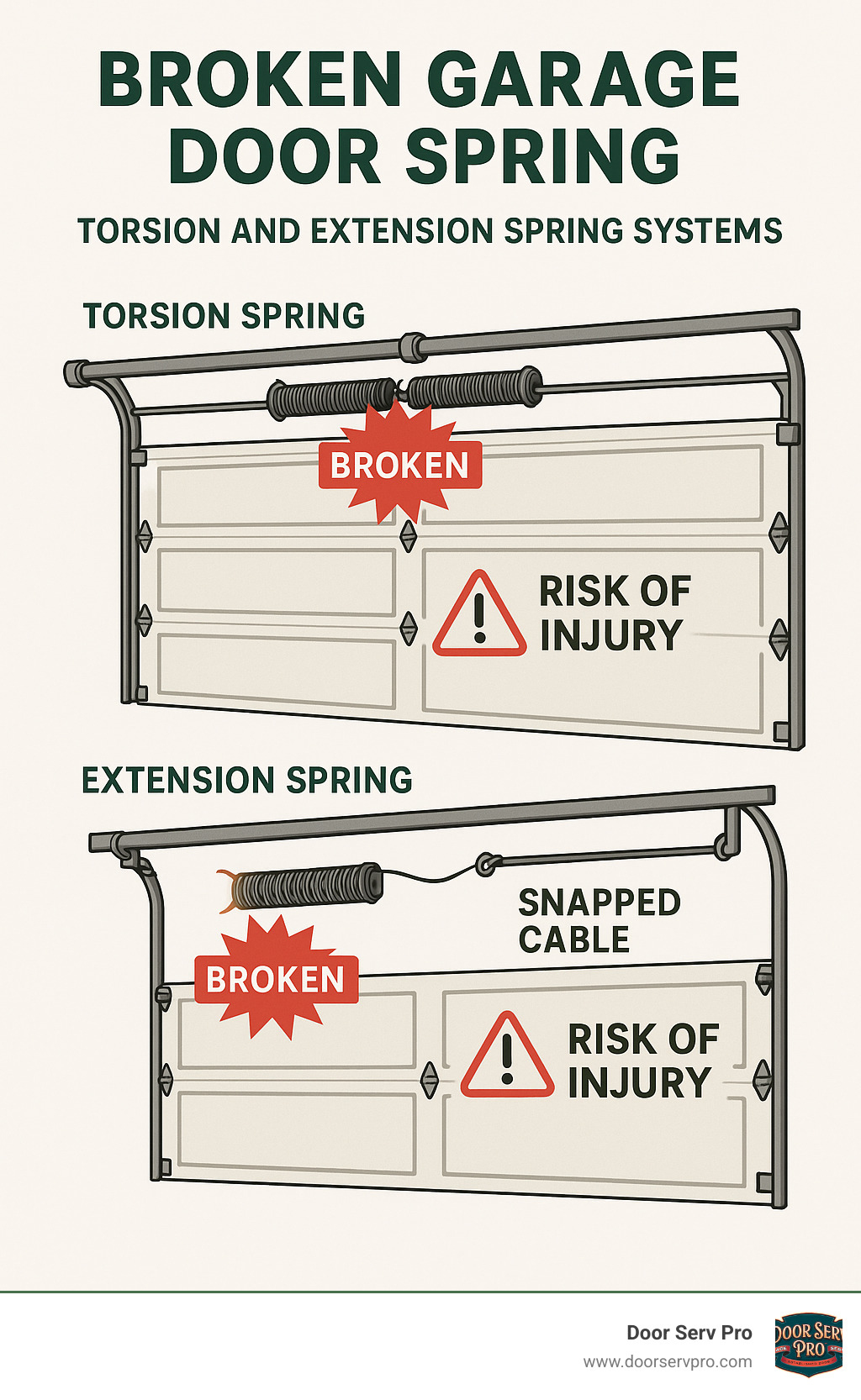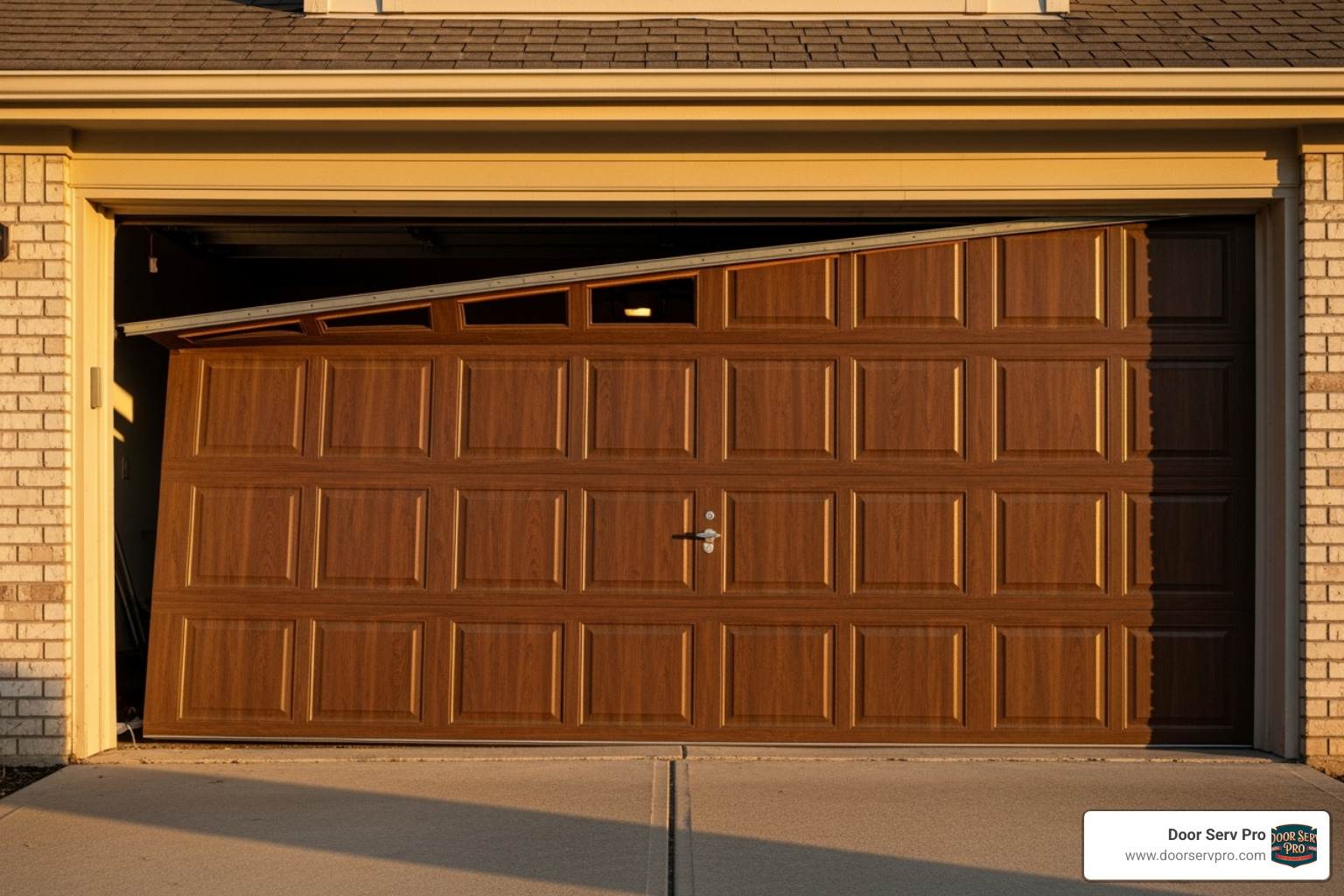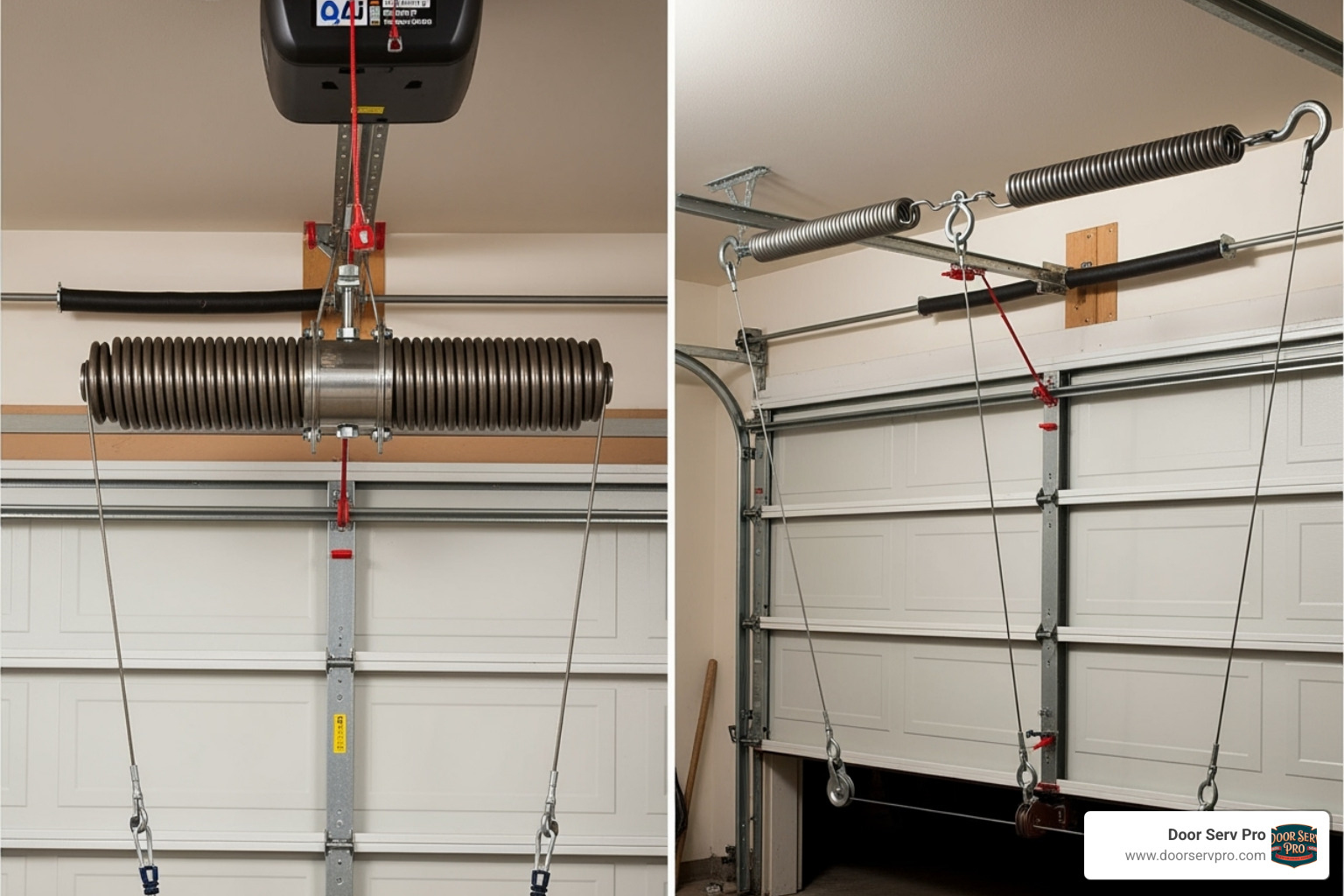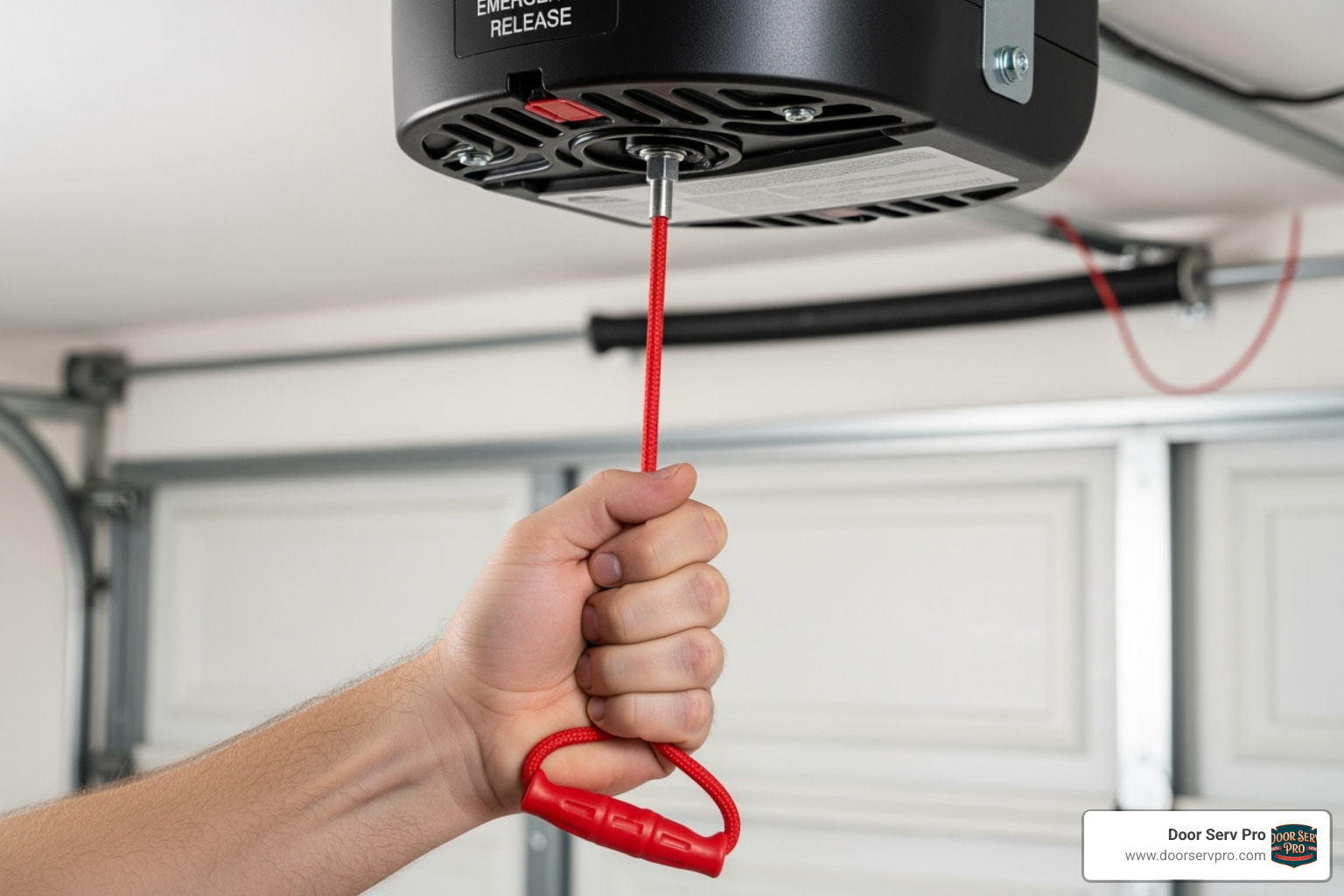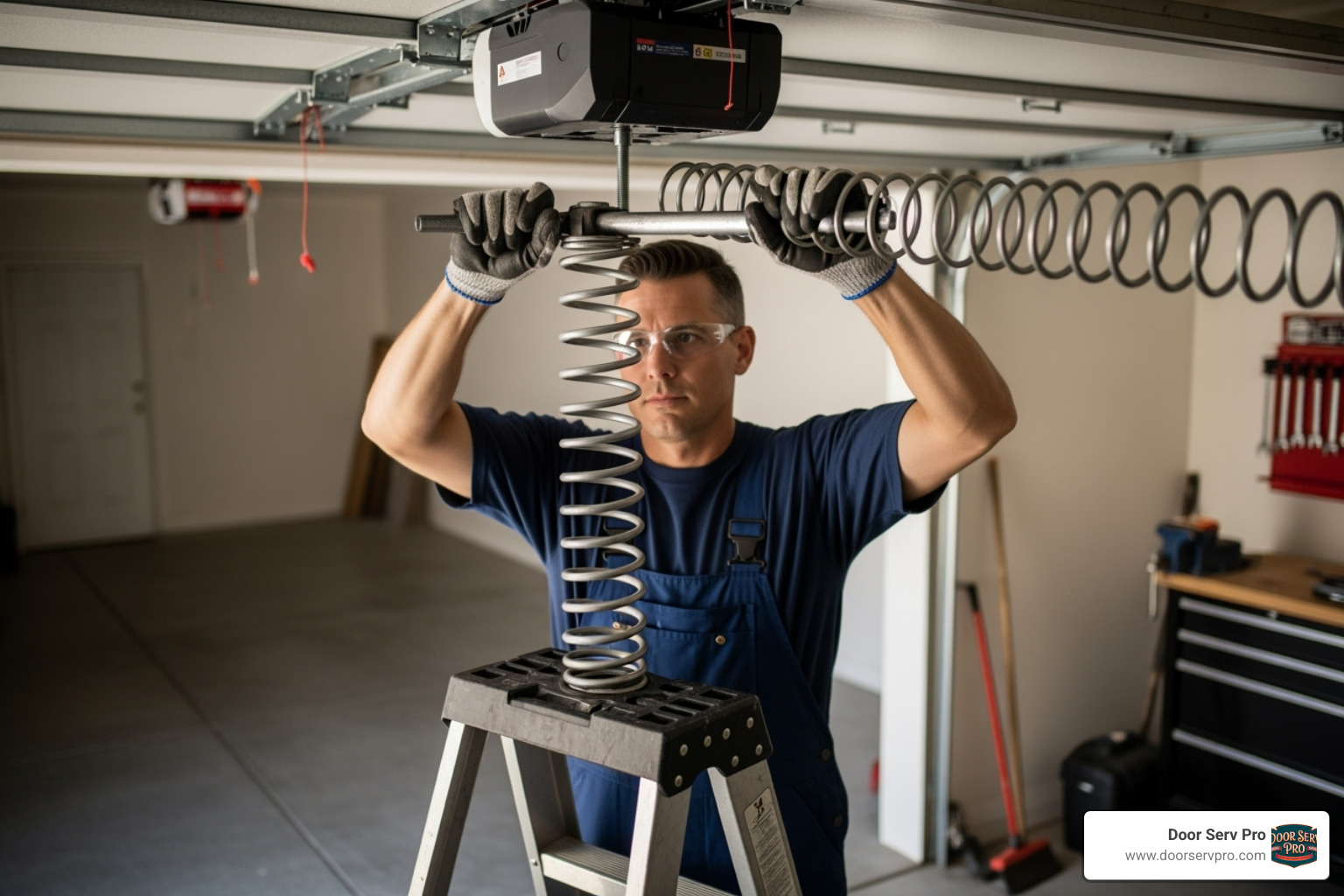When Your Garage Door Spring Fails: Identifying the Problem
A broken garage door spring can bring your daily routine to a screeching halt, leaving you with a garage door that won’t budge or has crashed down unexpectedly.
Quick Diagnosis Checklist for Broken Garage Door Springs:
- Loud bang or pop – Often the first sign a torsion spring has snapped
- Door won’t open – Even with the opener running, the door stays put
- Crooked or uneven door – One side hangs lower than the other
- Door slams shut quickly – No controlled descent when closing
- Visible gap in the spring – You can see where the spring has separated
- Heavy door when lifted manually – Takes significant effort to raise by hand
- Loose or snapped cables – Often a secondary result of spring failure
Garage door springs are essential, using stored energy to counterbalance your door’s 150-to-400-pound weight. When a spring fails, the door becomes dead weight that your opener motor cannot lift.
The danger of a broken spring is real, posing risks of serious injury and property damage. Understanding the problem and your safe options is crucial to prevent a dangerous situation.
First, The Diagnosis: Is Your Garage Door Spring Really Broken?
When your garage door suddenly stops working, the springs are often the culprits. Recognizing the signs of a broken garage door spring is the first step toward a safe and effective solution.
Key Signs of a Broken Garage Door Spring
These tell-tale signs are clear indicators that it’s time for professional attention.
- Loud Pop or Bang: Many homeowners hear a loud bang, like a firecracker, from the garage. This is the most common sign of a torsion spring snapping under tension.
- Visible Gap in the Spring: Look at the springs. A torsion spring will have a visible gap in the coil, while an extension spring may look stretched out.
- Crooked or Uneven Door: If one side of the door hangs lower than the other, it’s a clear sign one of the two springs has broken.
- Door Slams Shut Quickly: A healthy door closes smoothly. If your door slams shut, the springs are no longer counterbalancing its weight.
- Heavy Door When Lifted Manually: With the door closed, pull the red emergency release cord. If the door feels extremely heavy to lift manually, the springs have failed. A balanced door should feel light and stay put when lifted halfway.
- Loose or Snapped Cables: The lifting cables may become loose, frayed, or snap when a spring breaks, which can cause the door to go off-track.
- Opener Motor Running, But Door Won’t Move: If you hear the opener motor running but the door isn’t moving, the opener can’t lift the door’s full weight without help from the springs.
Understanding these signs is crucial for knowing when to seek help. For more insights into why garage door springs fail, you can explore our detailed guide on Common Causes of Garage Door Spring Repair.
What Happens When a Spring Fails?
A broken spring creates immediate risks and can damage your entire garage door system.
- Opener Strain and Motor Burnout: Without the springs, your opener is forced to bear the door’s entire load, which can quickly lead to motor burnout.
- Door Free-Fall Risk: This is the most dangerous consequence. A door can free-fall without warning, posing a severe risk of injury or death to anyone or anything in its path.
- Security Risk: If your door is stuck open, it compromises the security of your home.
- Damage to Panels or Tracks: The sudden imbalance can twist the door, knock it off its tracks, or damage panels, turning a simple spring repair into a major overhaul.
We cannot stress enough the importance of addressing a broken spring immediately. Learn more about why it’s crucial not to delay repairs in our article: 5 Reasons You Should Not Ignore Garage Door Spring Repair.
Understanding the Heart of Your Garage Door: Torsion vs. Extension Springs
Understanding your spring type helps diagnose the problem. Springs act as the muscle for your garage door, counterbalancing its weight. When a broken garage door spring occurs, the type—torsion or extension—determines the risks and repair options.
For homeowners who want to dive deeper into spring mechanics, our comprehensive guide Understand Garage Door Springs Cumberland covers everything you need to know.
Torsion Springs Explained
Torsion springs are the modern, safer standard, especially for heavier doors. Mounted on a metal shaft above the door, they twist to store energy as the door closes and unwind to help it open. This system provides smooth, balanced movement. When a torsion spring breaks, it typically stays on the shaft, reducing the risk of flying parts.
For everything you ever wanted to know about these workhorses, check out our detailed guide: Navigating Torsion: Your Complete Guide to Garage Door Spring Repair.
Extension Springs Explained
Found on older or lighter doors, extension springs run alongside the horizontal tracks. They work by stretching to store energy as the door closes and contracting to help it open. This system can cause jerkier movement. Safety cables are essential for extension springs. These cables run through the spring to contain it if it breaks, preventing it from flying across the garage and causing injury or damage.
Want to understand the key differences between these systems? Our comparison guide Extension vs Torsion Springs in Cresaptown breaks down everything you need to consider.
[TABLE] Comparing Torsion and Extension Springs
| Feature | Torsion Springs | Extension Springs |
|---|---|---|
| Location | Mounted horizontally above the door opening | Run parallel to horizontal tracks on both sides |
| How they Work | Twist and unwind on a shaft to store energy | Stretch and contract to store energy |
| Safety | Generally safer upon failure (contained on shaft) | Require safety cables to prevent dangerous projectiles |
| Lifespan | Typically 7,000-10,000 cycles (longer) | Typically 5,000-10,000 cycles (shorter) |
| Cost | Generally higher initial cost | Generally lower initial cost |
| Performance | Smoother, more balanced operation | Can be less smooth, more prone to jerky movement |
| Ideal Door Type | Heavier, larger garage doors | Lighter, one-piece doors, or older installations |
While both systems lift your door, torsion springs generally offer superior performance and safety. Knowing your spring type is key to understanding the repair needs and safety precautions for a broken garage door spring.
What to Do When You Have a Broken Garage Door Spring: A Safety-First Guide
When you find a broken garage door spring, your first thought might be to force the door open or attempt a DIY fix. Stop. Garage door springs are under extreme tension and are incredibly dangerous when broken. They are responsible for lifting a 150- to 400-pound door, and a failure releases powerful force that requires extreme caution.
The Dangers of a Broken Garage Door Spring
A broken spring is a serious safety hazard. The primary dangers include:
- Uncontrolled Door Drop: Without the spring’s support, the heavy door can slam shut, causing severe injury or crushing property like your car.
- Serious Personal Injury: Snapping springs or cables can cause severe cuts, broken bones, or worse. The high tension involved makes any failure violent and unpredictable.
- Opener Motor Damage: Forcing your opener to lift the door’s full weight will quickly burn out the motor.
This is why professional repair is essential. For more information on garage door safety, consult resources from the International Door Association. The risks of a DIY repair are simply too high.
For comprehensive safety information, check out our guide on Safe Garage Door Spring Repair.
How to Manually Open the Door (With a Helper)
If you must open the door before a technician arrives, do so with extreme caution and never attempt it alone. You will need at least one strong helper.
- Disengage the Opener: With the door fully closed, pull the red emergency release cord.
- Clear the Area: Remove all people, pets, and valuables from the garage. Wear gloves and safety glasses.
- Lift Together: Position one person on each side of the door. Lifting from the center with your legs, raise the door slowly and evenly. It will be extremely heavy.
- Secure the Door: Once fully open, clamp locking pliers tightly onto the vertical tracks just below the bottom rollers on both sides. This is critical to prevent the door from crashing down.
How to Manually Close the Door
Closing the door requires the same caution.
- Prepare to Lower: With your helper, get a firm grip on the door.
- Remove Clamps: Carefully remove the locking pliers from the tracks.
- Control the Descent: Guide the door down slowly and evenly. Do not let it slam.
- Leave Opener Disengaged: Do not re-engage the opener until the springs have been professionally replaced.
These manual steps are for emergencies only. The only safe, permanent solution for a broken garage door spring is professional replacement. Learn more about our Emergency Garage Door Spring Repair: What You Need to Know services.
The Long-Term Fix: Repair, Replacement, and Prevention
After addressing immediate safety, the only real solution is professional repair. While a DIY fix might seem tempting, garage door springs are not a homeowner project. The risk of injury and property damage is too high without specialized tools and training. Professional replacement is the only way to ensure a safe, reliable, and long-lasting fix for your broken garage door spring.
Lifespan and Replacement Cycles
Garage door springs have a finite lifespan, measured in cycles (one open and close).
- Standard Springs: Rated for 7,000 to 10,000 cycles, lasting the average family 7-12 years.
- High-Cycle Springs: Rated for 20,000+ cycles, these can last 15-20 years and are ideal for high-traffic garages.
If your door has two springs and one breaks, always replace both. They have the same amount of wear, and the second one is likely to fail soon. Replacing both at once saves you money on a future service call and ensures the door remains balanced and operates smoothly. Spring longevity is also affected by material quality, proper installation, and environmental factors like humidity.
Learn more about The Importance of Regular Inspections for Garage Door Spring Repair.
Estimating the Cost of Replacement
The cost of spring replacement depends on several factors:
- Spring Type: Torsion and extension springs have different part and labor costs.
- Door Weight and Size: Heavier doors require stronger, more expensive springs.
- Single vs. Double System: Replacing both springs in a two-spring system is recommended and will affect the total cost.
- Collateral Damage: A broken spring can damage cables, drums, or rollers, which may also need replacement.
A professional technician will provide a clear, detailed estimate after inspecting your system. For guidance on selecting the right professionals, check out Finding the Right Garage Door Spring Repair Service: Key Factors.
How to Prevent Future Spring Damage
You can extend the life of your new springs with simple preventive care:
- Lubricate Regularly: Apply a silicone-based lubricant to springs, hinges, and rollers every few months to reduce friction.
- Perform Balance Tests: Periodically disconnect the opener and lift the door halfway. It should stay in place. If it moves, the springs need adjustment.
- Visually Inspect: Look for rust, corrosion, or gaps. Listen for unusual noises.
- Schedule Professional Maintenance: An annual tune-up by a technician can catch issues early, ensuring long-term reliability and preventing premature failure.
For more detailed maintenance guidance, read Garage Door Spring Repair: Benefits of Regular Maintenance.
Frequently Asked Questions about Broken Springs
When dealing with a broken garage door spring, homeowners often have the same questions about cost, safety, and next steps.
How much does it cost to replace garage door springs?
This is the first question on most homeowners’ minds. The cost varies based on several factors, including the type of spring (torsion vs. extension), your door’s weight and size, whether you’re replacing one or both springs, and if there’s any collateral damage to other parts like cables or rollers. A professional service will provide a transparent, detailed quote after an inspection.
Should I replace both springs if only one is broken?
Yes, absolutely. If your door has two springs, you must replace both at the same time. Both springs have endured the same amount of wear, so if one has failed, the other is sure to follow. Using one new and one old spring creates an imbalance that will strain your opener, damage the door, and cause the new spring to wear out faster. Replacing both is safer and more cost-effective in the long run.
Can I repair a broken garage door spring myself?
No. We say this for your own safety. Garage door spring replacement is one of the most dangerous home repairs. The springs are under extreme tension, and an uncontrolled release of energy can cause severe injury or even death. This job requires specialized tools (like winding bars) and knowledge that homeowners do not have. An incorrect repair can also cause further damage to your door and opener. Please leave this job to a trained professional.
Your Next Step for a Safe and Secure Garage
When you have a broken garage door spring, the situation is both urgent and dangerous. Putting off the repair or attempting to use the door can lead to further damage to your opener and poses a significant safety risk. A DIY repair is not an option due to the extreme tension in the springs, which requires specialized tools and expertise to handle safely.
Professional repair is the only safe choice. It provides long-term value and peace of mind, ensuring your entire system is correctly balanced and functions reliably for years. This protects your opener, prevents future issues, and secures your home.
At Door Serv Pro, our NATE-certified technicians have over 25 years of experience handling every type of spring failure. We bring the right tools and safety protocols to restore the security and functionality of your home’s largest moving part. We don’t just fix a broken part; we deliver a lasting solution.
Don’t let a broken spring compromise your safety. We’re here to help with round-the-clock service and a 100% satisfaction guarantee across West Virginia, Virginia, Pennsylvania, and Maryland. Contact us for expert garage door services in Hagerstown, MD and let us get your life back on track. After all, we don’t just fix doors – we create lasting impressions, one entryway at a time.

